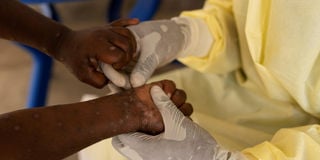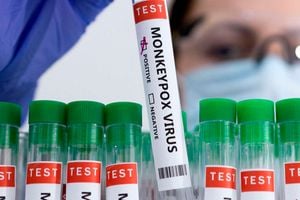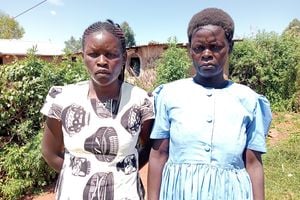Explainer: What you need to know about Mpox

A nurse takes a sample from a child declared a suspected case of Mpox - an infectious disease caused by the monkeypox virus that sparks off a painful rash, enlarged lymph nodes and fever.
What you need to know:
- The CDC defines Mpox as a viral disease caused by the monkeypox virus. Erstwhile, it was called monkeypox, but during the previous outbreak in 2022, it was renamed to Mpox because it was interpreted as racist and discriminatory based on the language that people used online.
- On Wednesday evening, the World Health Organisation (WHO) declared Mpox a public health emergency of international concern.
About 15 days ago, Kenya reported its first Mpox case. The index case was a truck driver travelling from Uganda to Rwanda through Kenya.
So far, that is the only case that has been officially reported by the Health ministry. That single case is still of concern, as it adds Kenya to the continental map of countries that have now registered Mpox cases.
On Wednesday evening, the World Health Organisation (WHO) declared Mpox a public health emergency of international concern.
Their announcement came a few days after the Africa Centres for Disease and Prevention (Africa CDC) declared a public health emergency, but for the African region.
Why is this a public health emergency of international concern?
In just two years, new Mpox cases have been reported.
The previous outbreak started in the United Kingdom and was also reported in some parts of Europe. The Mpox type that spread in 2022 was mostly the Clade II.
In May 2023, WHO Director-General Tedros Ghebreyesus declared the 2022 outbreak that was also a public health emergency of international concern over. A few months later –in September 2023, a new Clade Ib was detected in the Democratic Republic of Congo.
The disease has since spread in 22 out of the 26 provinces of DRC. Children are more exposed to the disease in the DRC as about two-thirds of the infections are detected in people under the age of 15.
Since the first case was announced last year, 14,000 new cases have been reported and more than 500 people have died. So far, about 13 African countries, including those that have never been affected like Burundi, Kenya, Rwanda, and Uganda, have reported new cases.
Do we have any treatment or vaccines for Mpox?
At the moment, there is no approved treatment for Mpox, doctors mostly treat the symptoms of the disease. There are existing therapeutics for patients who have severe illness.
Tecovirimat is the most preferred therapeutic, others include; Brincidofovir and Vaccinia Immune Globulin (VIGIV).
Those affected by the eye as a result of the infection may be treated with the trifluridine ophthalmic solution but this has to be advised by an ophthalmologist. On August 9, the WHO invited manufacturers to submit their products for Emergency Use Listing. Only two vaccines have been approved so far, including Bavarian Nordic’s Jynneos, and LC16, made by KM Biologics.
How do you stay safe from the disease when taking care of an infected person?
Vaccination is a form of prevention, but, at the moment, especially in Africa…most countries do not have access to vaccines. At home, therefore, it is recommended that people should avoid skin to skin contact with infected persons, or animals. You can also avoid sexual contact with infected people as well as sharing utensils and personal items such as towels or bedding. Just like during the Covid-19 pandemic, remember to wash your hands at all times.
What is Mpox?
The CDC defines Mpox as a viral disease caused by the monkeypox virus. Erstwhile, it was called monkeypox, but during the previous outbreak in 2022, it was renamed to Mpox because it was interpreted as racist and discriminatory based on the language that people used online.
While it was first discovered in monkeys by scientists in Denmark in 1958, the first human case in Africa was discovered in the Democratic Republic of Congo (DRC) in 1970. Mpox is a relative to the small pox, only that it causes milder rashes to those that are infected and fewer deaths compared to smallpox.
Scientists still do not know the natural reservoir for the virus, but it is mostly found in animals like squirrels and monkeys.
There are two types of Mpox, commonly known as clades –Clade I and Clade II. Clade I is more deadly compared to Clade II.
How does it spread?
Mpox is mostly transmitted when a person comes in direct contact with an infected person mostly through the mouth or genitals. People with multiple sexual partners are highly susceptible to getting an infection, but if a member of your household has the disease, you may also be infected, if you touch their lesions.
The virus can also jump from an animal to human being if the animal scratches or bites a person.
What are some of the symptoms associated with Mpox?
The most common symptoms include; rash, fever, sore throat, headache, muscle aches, back pain, low energy and swollen lymph nodes. The rashes are fluid-like and are painful. The incubation period for the Mpox virus is about 1 to 2 weeks, and during this time, the infected person cannot pass it on to another.
The WHO says that sometimes, the disease may escalate to bring up other complications such as; pneumonia, loss of vision; pain or difficulty swallowing, vomiting and diarrhoea causing severe dehydration or malnutrition; sepsis (infection of the blood with a widespread inflammatory response in the body), inflammation of the brain (encephalitis), heart (myocarditis), rectum (proctitis), genital organs (balanitis) or urinary passages (urethritis), or death.





